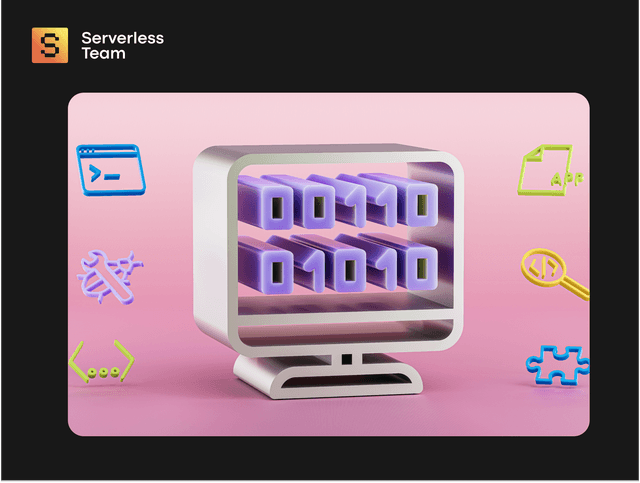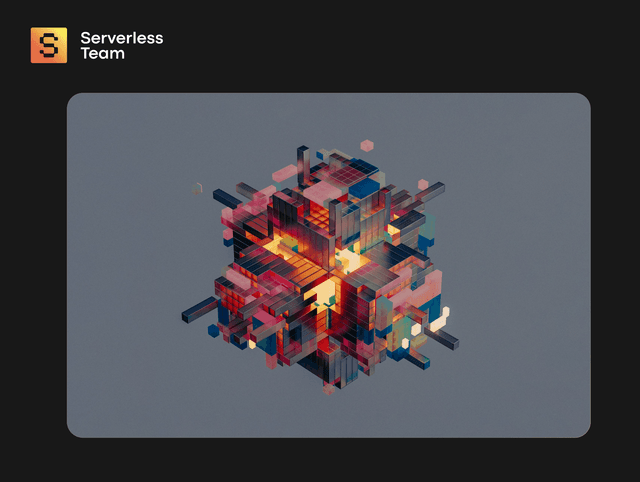In the vast landscape of software architecture, microservices have emerged as a beacon of efficiency and flexibility. Whether you're a seasoned architect or a budding developer, this guide promises a comprehensive exploration of the top microservices frameworks.

We take care of serverless development so you can focus on your business
Don't want to wait for our site launch? Let's talk about your idea right now.


Understanding Microservices
Microservices, often termed "microservices architecture," refers to developing software systems that break applications into smaller, independent, and loosely coupled services. Each service runs a unique process and communicates through a well-defined, lightweight mechanism to serve a distinct business goal.
Now, why has this approach caught the eye of developers and businesses alike?
Advantages of Microservices Architecture for Scalability:
- Granular Scalability: Unlike monolithic structures, where the entire application needs to be scaled, microservices allow for the independent scaling of specific components. As your user base grows, you can selectively scale up the services that are under the most load, saving resources and costs.
- Flexibility in Technology Stacks: Each microservice can be written using the technology best suited for its requirements. This decoupled nature means teams can adopt new technologies without completely overhauling the existing system.
- Faster Time to Market: With microservices, multiple teams can develop, test, and deploy services independently. This parallel development results in quicker releases and a faster response to market demands.
- Improved Fault Isolation: A failure in one service doesn’t mean the entire application goes down. This localized fault isolation ensures higher availability and user satisfaction.
- Optimized Resource Utilization: By breaking down tasks into smaller services, microservices ensure that resources, be it computational power or storage, are used more effectively and efficiently.
Embracing microservices can be a game-changer, especially when scalability is at the forefront of your application goals. This transition becomes smoother and more efficient with the right framework for microservices.
Let's explore the best microservices frameworks that are making waves in the tech landscape.

Kyrylo Kozak
CEO, Co-founderGet your project estimation!

Top 10 Microservices Frameworks: Empowering Your Architecture
Are you wondering which framework is best for microservices? In the dynamic world of software development, selecting the right framework for microservices architecture can significantly influence your project's success. These frameworks offer a structured approach to building, deploying, and managing microservices, easing the development process and enhancing the scalability of your applications.
Our Ultimate Favorite — Serverless Framework
Serverless is a free, open-source framework that facilitates building applications comprised of microservices that run in response to events. For us, it’s one of the best frameworks for microservices out there, and here’s why:
Key features:
- Cloud Agnostic: Supports multiple cloud providers such as AWS Lambda, Azure Functions, Google Cloud Functions, etc.
- Event-Driven: Easily set up applications to respond to various events like HTTP requests, database operations, and more.
- Local Testing: Allows developers to test serverless functions locally before deploying.
- Plugin Support: Extensible and customizable with a wide variety of plugins.
- Deployment Automation: Simplifies deployment with automated workflows.
- Integrated Monitoring: Seamless integration with monitoring tools. In essence, the Serverless Framework offers a comprehensive toolset for serverless application deployment, though carefully considering the project’s needs and cloud provider limitations is crucial.
| Pros | Cons |
|---|---|
| Flexibility | Learning Curve |
| With support for multiple cloud providers, you aren't locked into one platform. | This might be steep for those unfamiliar with serverless or the cloud platform. |
| Community Support | Limited by Providers |
| Due to its popularity, there's a large community which means better support, plugins, and frequent updates | Dependent on the limits of the cloud provider being used, which might restrict some functionalities. |
| Development Speed | Complexity |
| Speeds up the development and deployment process with automated workflows. | For larger projects, configuration and deployment can become complex. |
Reasons to Use the Serverless Framework:
- Cost-Effective: Serverless architectures can often lead to lower operational costs as you only pay for the actual compute time your application consumes, not for server uptime.
- Rapid Deployment: With its automated workflows and built-in deployment mechanisms, pushing changes or launching new features can be achieved quickly.
- Scalability: Automatically scales your application based on demand without any manual intervention. You don’t need to pre-provision or over-allocate resources.
- Unified Experience: If you're juggling applications on different cloud providers, the Serverless Framework provides a consistent development experience across all of them.
- Robust Ecosystem: The extensive plugin system and large community mean you can often find pre-built solutions for common challenges, thereby avoiding "reinventing the wheel."
- Integrated Best Practices: The framework promotes best practices for serverless application development, ensuring your apps are built on a solid foundation from day one.
- Focus on Core Logic: By abstracting away much of the boilerplate and configuration, developers can focus more on the business logic, leading to faster and more efficient development cycles.
Opting for the serverless microservices framework is not just about adopting a tool but a mindset shift. It encourages thinking about events, scalability, and, most importantly, freeing developers from the intricacies of server management to concentrate on code and creating value.
Spring Boot with Spring Cloud Framework
Spring Boot is an open-source micro framework from Pivotal that allows developers to build stand-alone, production-ready Spring applications. Combined with Spring Cloud, it provides a suite of tools to quickly build cloud-native apps that can run on external platforms like AWS, Azure, and Google Cloud or on-premises solutions.
Key Features:
- Auto Configuration: Spring Boot reduces lots of development time with its convention over the configuration paradigm.
- Production-Ready: Integrated actuator module provides runtime information without the need for extra configurations.
- Embedded Tomcat: No need for external setups; web applications run out of the box.
- Microservices Ready: Spring Cloud makes it easy to build and orchestrate microservices applications.
- Configuration Management: Spring Cloud provides solutions like Spring Cloud Config Server for centralized configuration.
- Service Discovery: Tools like Eureka are embedded for service registration and discovery.
- Load Balancing: With Ribbon and Feign, load balancing becomes a breeze.
- API Gateway: Zuul provides dynamic routing, monitoring, and security.
| Pros | Cons |
|---|---|
| Quick Start | Memory Consumption |
| Spring Boot allows for the rapid development of production-ready applications. | Spring-based applications often consume more memory compared to lightweight frameworks. |
| Flexibility | Learning Curve |
| With its extensive modularity, you only add necessary components. | For beginners, understanding the vast ecosystem might be overwhelming. |
| Large Ecosystem | Overhead |
| Abundant plugins, extensions, and large community support | Auto-configurations might add unnecessary overhead if not correctly managed. |
| Integrated Security | |
| Spring Security provides robust mechanisms for authentication and authorization. | |
| Consistent | |
| Offers a consistent development platform for both cloud-native and traditional applications. |
Reasons to Use Spring Boot with Spring Cloud:
- Rapid Development: Get a microservice up and running in a matter of minutes.
- Versatility: Suitable for various applications, from monoliths to microservices.
- Adaptive: The frameworks adapt to your style, not vice versa. Focus on business logic and let Spring handle the rest.
- Reliability: Developed and maintained by Pivotal, which has a track record for high-quality enterprise software.
- End-to-End Solutions: From database interactions and cloud configurations to web interfaces, Spring has got you covered.
The Spring Boot and Spring Cloud combination offers a formidable toolset for new projects and migrating existing services to a cloud-native environment. However, it's essential to understand the ecosystem to harness its full power effectively.
Eclipse Vert.X Framework
Eclipse Vert.X is a polyglot event-driven application framework for microservices that runs on the Java Virtual Machine. It's designed for building scalable, reactive applications emphasizing concurrency and low latency. Its asynchronous nature sets it apart from traditional Java frameworks.
Key Features:
- Polyglot: Supports multiple languages, including Java, JavaScript, Groovy, Ruby, and Kotlin.
- Event-Driven: Built around a robust event bus that spans the client and server side.
- High Concurrency: Designed to handle many connections with minimal threads.
- Reactive APIs: Offers a comprehensive set of reactive APIs for broad use cases.
- Microservices Ready: Provides built-in support for building resilient microservices.
- Modular: Its modular design allows for creating applications with only the components you need.
- Embeddable: Vert.X can be embedded in other applications or can be used as a standalone server.
| Pros | Cons |
|---|---|
| Performance | Asynchronous Complexity |
| Asynchronous by nature, it's optimized for high-performance applications. | Developing in a fully asynchronous environment can be challenging for those new to the paradigm. |
| Flexibility | Learning Curve |
| Can be used in both monolithic and microservice architectures. | Different from traditional Java frameworks, requiring a shift in mindset. |
| Scalability | Lesser Recognition |
| Native support for clustering and message-passing between nodes. | It's not as widely recognized compared to giants like Spring, which may affect hiring or team ramp-up. |
| Small Footprint | |
| Lightweight, resulting in reduced container sizes and faster startup times. | |
| Community | |
| Backed by a thriving community and an array of extensions. |
Reasons to Use Eclipse Vert.X:
- Reactive Paradigm: If you aim for a reactive architecture, Vert.X is built from the ground up with this in mind.
- Polyglot Development: This lets you use the right language for the right task or integrate with teams having varied language expertise.
- Highly Concurrent Apps: Ideal for applications that require handling a vast number of simultaneous connections, such as chat applications or online games.
- Minimalistic Design: If you're looking for a lean microservices framework without any unnecessary bloat, Vert.X is a good pick.
- Integrated Toolset: This comes with a set of tools for building everything from web apps to TCP/HTTP servers and clients, offering a holistic development experience.
Eclipse Vert.X offers a versatile toolkit for building scalable and reactive applications. While it requires adapting to an asynchronous mindset, the benefits in performance, scalability, and responsiveness can be substantial for the right projects.
Oracle Helidon Framework
Oracle Helidon is a collection of Java libraries crafted to simplify the creation of microservices. It's Oracle's response to the growing demand for lightweight, fast, and reactive frameworks, allowing developers to create applications that can be seamlessly deployed on cloud platforms, particularly Oracle Cloud.
Key Features:
- Two Flavors: Helidon SE, the lightweight micro-framework, and Helidon MP, an implementation of MicroProfile for enterprise-level needs.
- Reactive WebServer: A non-blocking web server at Helidon SE's core.
- Config System: Supports multiple config sources and formats to provide flexible configurations.
- Integrated Health Checks: Built-in tools to check the application's health and its components.
- GraalVM Support: Can be compiled into a native executable with GraalVM for reduced startup times.
- Metrics Collection: Out-of-the-box support for gathering and reporting metrics.
- Security Infrastructure: A comprehensive serverless security infrastructure that's customizable.
| Pros | Cons |
|---|---|
| Lightweight | Younger Framework |
| Crafted to have minimal overhead, resulting in rapid application boot times. | Compared to seasoned players, it's relatively new and thus might lack some advanced features. |
| Reactive | Smaller Community |
| Helidon SE provides a reactive model catering to responsive applications. | Its user base isn't as vast as the likes of Spring or Quarkus, which can affect community-driven help. |
| Interoperability | Learning Curve |
| Being based on MicroProfile, Helidon MP can interoperate with other MP-based frameworks. | For teams unfamiliar with reactive programming or MicroProfile, there might be an initial learning period. |
| Flexibility | |
| You can choose a bare-metal approach with Helidon SE or go for a higher-level abstraction with Helidon MP. | |
| Oracle Ecosystem Integration | |
| A natural choice if your stack heavily involves Oracle products. |
Reasons to Use Oracle Helidon:
- Highly Reactive Systems: If your goal is a non-blocking, reactive application, Helidon SE is tailored for that.
- Seamless Oracle Integration: Helidon becomes a natural and efficient choice, especially if you're using Oracle Cloud.
- MicroProfile Benefits: Helidon MP offers the advantages of MicroProfile, including standardized APIs for most microservice functionalities.
- Customization Needs: Helidon provides tools, but it's unopinionated, letting you craft applications your way.
- Modern Development: If you're looking to adopt newer standards and tools, like GraalVM, Helidon is forward-compatible.
In essence, Oracle Helidon, with its dual model, provides options for both micro-framework enthusiasts and enterprise developers, making it a versatile choice for modern Java microservice development.
GoMicro Framework
GoMicro is an RPC framework designed to build microservices in the Go language. It emphasizes simplicity and performance, leveraging the strengths of Go to provide developers with a fast, straightforward means of crafting scalable microservice-based applications.
Key Features:
- Pluggable Interface: It allows developers to plugin different tools according to their requirements.
- Service Discovery: Automatic service registration and name resolution.
- Load Balancing: Built-in load balancing, making it easy to distribute tasks across services.
- Synchronous Communication: GoMicro uses RPC for synchronous communication.
- Event-Driven Microservices: With GoMicro's built-in event-driven communication.
- Authentication & Authorization: Built-in solutions to secure microservices.
- API Gateway: Provides a gateway to expose the services.
| Pros | Cons |
|---|---|
| Performance | Go-centric |
| Written in Go, GoMicro offers high performance with a minimal footprint. | While Go's strengths are many, being solely tied to Go may limit integration with services written in other languages. |
| Concurrency | Steep Learning Curve |
| Leverages Go's native capabilities for concurrent processing. | Requires proficiency in Go and may present a learning curve for those unfamiliar with the language or microservice principles. |
| Modularity | Less Mature |
| The pluggable interface ensures that services can be easily extended or changed. | Compared to heavyweights like Spring Cloud, it might lack some advanced features. |
| Easy Deployment | |
| Seamless deployment in Docker containers or Kubernetes. | |
| Oracle Ecosystem Integration | |
| A natural choice if your stack heavily involves Oracle products. |
Reasons to Use GoMicro:
- Performance-driven Applications: If application speed and performance are top priorities, GoMicro leverages Go's strengths to the fullest.
- Simple Microservice Deployment: For projects where fast deployment and scaling are crucial, GoMicro's built-in features can significantly reduce the time to market.
- Go Ecosystem: If your team is proficient in Go or plans to centralize around the Go ecosystem, GoMicro is a natural fit.
- Event-Driven Systems: GoMicro's inherent support for event-driven microservices ensures efficient real-time data and operations handling.
- Minimalist Approach: For teams that prefer lean frameworks without unnecessary bloat, GoMicro provides the necessary features without the overhead.
In a nutshell, GoMicro is the go-to choice (pun intended) for teams looking to harness the power of Go in the realm of microservices, blending speed, simplicity, and modularity.
Moleculer Framework
Moleculer is a progressive microservices framework for Node.js. Designed with ease of use, speed, and scalability, it offers developers powerful tools and capabilities for building efficient and resilient microservices architectures.
Key Features:
- Request-Reply Concept: Supports the request-reply concept, which is essential for microservices communication.
- Service Discovery: Provides automatic service discovery to detect nodes & services.
- Load Balancing: Distributes requests among available services using different strategies.
- Event-driven Architecture: Supports event-driven architecture with balancing and acknowledgment.
- Fault Tolerance: Built-in fault tolerance features like circuit breaker and bulkhead.
- Middleware System: Allows developers to extend the framework with additional functionalities.
- Caching: Comes with powerful caching solutions to boost performance.
| Pros | Cons |
|---|---|
| Fast & Efficient | Node.js Specific |
| Provides high performance and low overhead, which is essential for microservices. | Limited to the Node.js environment, which might not suit all projects. |
| Highly Scalable | Learning Curve |
| Built for scalability from the ground up, making it easy to scale services horizontally. | While it's designed to be user-friendly, there's a learning curve for those new to microservices or Node.js. |
| Modular Structure | Younger Ecosystem |
| Everything is plugin-based, allowing flexibility and customizability. | Compared to some older frameworks, its ecosystem is younger which may lack certain third-party integrations. |
| Actively Maintained | |
| Has an active community that's responsive and continually improving the framework. | |
| Oracle Ecosystem Integration | |
| A natural choice if your stack heavily involves Oracle products. |
Reasons to Use Moleculer:
- Node.js Projects: If your team specializes in Node.js, Moleculer provides a natural and powerful framework for microservices.
- Performance-Centric Applications: Its built-in caching and efficient design ensure high-speed performance.
- Event-Driven Systems: Moleculer is particularly well-suited for event-driven architectures, ensuring real-time responsiveness.
- Flexible & Customizable: The modular design allows you to tailor your microservices setup to your needs.
- Active Development & Community: If staying up-to-date with the latest trends and improvements is vital, Moleculer's active community ensures you're always ahead.
In a nutshell, Moleculer is a robust choice for teams diving into the Node.js microservices framework world, offering a blend of performance, flexibility, and modern design principles.
Quarkus Framework
Quarkus is a full-stack, Kubernetes-native Java framework for microservices optimized for GraalVM and HotSpot, tailored for serverless applications. Boasting a "Supersonic, Subatomic Java" tagline, Quarkus offers a unique blend of runtime efficiency, developer joy, and the Java standards developers are accustomed to.
Key Features:
- Live Coding: Quarkus's live coding feature reduces development time by instantly reflecting code changes.
- Unified Imperative & Reactive Development: Seamlessly integrates the imperative and reactive development models.
- Kubernetes-Native: Designed for a Kubernetes-centric environment, offering cloud-first applications.
- Optimized for GraalVM & HotSpot: Can produce small, fast, and lightweight applications optimized for GraalVM and HotSpot.
- Wide Extension Ecosystem: A vast library of extensions makes integrating various tools and technologies easy.
- Standards-Based: Adheres to familiar industry standards like Eclipse MicroProfile.
| Pros | Cons |
|---|---|
| Highly Performative | Still Maturing |
| Offers faster boot times and lower memory consumption than traditional Java frameworks. | Though reliable, Quarkus is relatively newer compared to other industry stalwarts. |
| Developer Joy | Learning Curve |
| The live coding feature and vast tools enhance the developer's experience. | Requires a shift in approach, especially for developers used to traditional Java EE development. |
| Flexibility | |
| Facilitates both imperative and reactive programming models, depending on your application needs. | |
| Continual Improvement | |
| The framework is under active development, receiving regular updates and improvements. | |
| Oracle Ecosystem Integration | |
| A natural choice if your stack heavily involves Oracle products. |
Reasons to Use Quarkus:
- Optimized Microservices: If you're looking for a Java framework for microservices, Quarkus is tailor-made.
- Kubernetes & Cloud Deployment: For applications that will be deployed on Kubernetes or in the cloud, Quarkus offers numerous advantages.
- Faster Development Cycle: The live coding feature dramatically reduces development and testing times.
- Modern Java Experience: Perfect for developers wanting to experience the modern evolution of Java without discarding industry standards.
- Serverless Ready: Its lightweight nature makes it ideal for serverless applications where cold start times and low resource utilization are crucial.
Quarkus is an exciting choice for developers keen on leveraging Java's power in a modern, cloud-native world, combining familiarity with innovation.
Micronaut Framework
Micronaut is a modern, JVM-based framework designed to create modular, easily testable microservice and serverless applications. With a foundation built on Java's future, Micronaut offers ahead-of-time (AOT) compilation to deliver runtime advantages without losing the benefits of Java's expressiveness and developer productivity.
Key Features:
- Ahead-of-Time (AOT) Compilation: Enhances startup speed, reduces memory usage, and optimizes performance.
- Reactive Programming: Built-in support for reactive programming with Netty.
- Cloud-Native Integration: Features first-class support for common cloud platforms like AWS Lambda, Google Cloud Function, and Azure Function.
- Modular Design: Provides flexibility to include only the necessary features, reducing application footprint.
- Serverless Ready: Designed with serverless computing in mind, ensuring optimal cold starts.
- Microservices-Optimized: Offers features such as service discovery, client-side load balancing, and distributed tracing.
| Pros | Cons |
|---|---|
| Fast Performance | Younger Ecosystem |
| Reduced memory footprint and quick startup time. | Compared to Spring Boot, it has a smaller ecosystem, though it's rapidly growing. |
| Easy Learning Curve | Some Learning Required |
| Intuitive for developers familiar with Spring and Grails. | While it’s familiar for Spring developers, some nuances need mastering. |
| Versatile Dependency Injection | |
| Compile-time dependency injection reduces overhead and increases speed. | |
| Integrated with Modern Tech | |
| Built-in support for reactive programming, serverless, and cloud-native apps. | |
| Oracle Ecosystem Integration | |
| A natural choice if your stack heavily involves Oracle products. |
Reasons to Use Micronaut:
- Performance-Critical Apps: Its AOT compilation ensures blazing-fast startup times and reduced memory usage.
- Serverless Enthusiasts: Those focusing on serverless architectures will find Micronaut to be a perfect match due to its fast cold starts.
- Cloud-Native Development: If you're gearing towards cloud platforms, Micronaut offers seamless integrations.
- Reactive Programming: It’s ideal for those committed to building reactive applications with Java.
- Modernized Java Development: For Java developers seeking modern features without straying far from their comfort zone.
Micronaut bridges the gap between the traditional Java world and the modern demands of microservices and serverless architectures, delivering speed, efficiency, and familiarity in one package.
Lightbend Lagom Framework
Lightbend Lagom is a reactive microservices framework specifically designed for Java and Scala developers. Lightbend, the company behind popular technologies like Akka and Play, develops it. Lagom streamlines the creation of resilient, elastic, and message-driven systems, promoting clean separation of concerns and ensuring loose coupling among components.
Key Features:
- Reactive by Design: Built on top of Akka and Play, it provides an inherently reactive platform.
- Developer Productivity: Incorporates features that enhance developer efficiency, such as hot code reload and integrated development environment support.
- Event Sourcing and CQRS: Inbuilt support for event sourcing and Command Query Responsibility Segregation (CQRS).
- Service Discovery: Integrated service registry and dynamic routing.
- Persistence: Offers out-of-the-box distributed persistence with asynchronous and event-driven database operations.
- Integration with Popular Tools: Seamless integration with Kafka and Cassandra.
| Pros | Cons |
|---|---|
| Scalability | Learning Curve |
| Lagom’s reactive nature ensures the system remains responsive under load. | It might be a bit steep for those unfamiliar with reactive systems or CQRS. |
| Resilience | Specialized Ecosystem |
| Built-in fault tolerance with self-healing properties. | Lagom has a specific set of tools and libraries, which might limit third-party integrations. |
| Flexibility | |
| Compatible with both Java and Scala. | |
| Integrated Platform | |
| Has a built-in development environment, aiding swift development and testing. | |
| Oracle Ecosystem Integration | |
| A natural choice if your stack heavily involves Oracle products. |
Reasons to Use Lightbend Lagom:
- Reactive Systems: For businesses aiming to build elastic systems that can respond to varying loads.
- Event-Driven Architectures: Lagom is ideal for systems that rely heavily on events, ensuring they are processed smoothly and reliably.
- High Resilience Requirements: Systems that can't afford downtime can benefit from Lagom's self-healing properties.
- Consistent Development Environment: For teams that want an out-of-the-box development environment to fast-track their development process.
- Integration with Other Lightbend Products: Organizations already invested in the Lightbend ecosystem (like Akka or Play) will find it a natural extension.
With its emphasis on resilience and reactivity, Lightbend Lagom is a potent choice for organizations keen on harnessing the power of event-driven microservices while ensuring they remain scalable and maintainable.
AxonIQ Framework
AxonIQ is a Java-based microservices framework that focuses primarily on building evolutionary, event-driven microservices. Designed around Domain-Driven Design (DDD), Command Query Responsibility Segregation (CQRS), and Event Sourcing principles, AxonIQ provides a robust platform for creating scalable and extensible systems.
Key Features:
- Event-Driven: Core support for Event Sourcing which ensures that all changes to an application's state are stored as a sequence of events.
- CQRS Enabled: Clear separation of command and query operations, enabling flexible scaling.
- Highly Extensible: Built to adapt to growing business needs.
- Axon Server: An all-in-one solution for CQRS and Event Sourcing applications.
- Saga Framework: Ensures complex business transactions are handled seamlessly.
- Distributed Command & Query Processing: Provides efficient handling of distributed commands and queries.
| Pros | Cons |
|---|---|
| Scalability | Complexity |
| Built from the ground up to support scalable microservice architectures. | With its focus on CQRS and Event Sourcing, there can be a steep learning curve for developers new to these patterns. |
| Flexibility | Potential Overhead |
| Modular design allows you to use only the parts of the Axon you need. | Can be perceived as too heavy for simpler applications that don't necessarily benefit from CQRS or event sourcing. |
| Enhanced Developer Productivity | |
| Reduces boilerplate code, helping developers focus on business logic. | |
| Streamlined Event Handling | |
| Built-in support for event processing and asynchronous communication. | |
| Oracle Ecosystem Integration | |
| A natural choice if your stack heavily involves Oracle products. |
Reasons to Use AxonIQ:
- Embrace Event-Driven Architecture: Perfect for businesses leveraging event-driven microservices.
- Complex Business Transactions: Axon's Saga mechanism is invaluable if your system needs to coordinate complex business transactions.
- Growth and Evolution: For those looking at a microservices architecture that can adapt and grow with business needs.
- Strong Focus on DDD: Teams or businesses aligned with Domain-Driven Design will find Axon aligning with their architectural vision.
- Integrated Solution: Axon Server provides an out-of-the-box solution to run your CQRS and Event Sourced applications.
AxonIQ, with its rich set of features and emphasis on event-driven microservices, offers a solid foundation for organizations aiming to build scalable and extensible systems, especially those inclined toward DDD and CQRS paradigms.
Choosing the right microservices framework depends on your project's requirements, team expertise, and long-term goals. Each framework brings its unique strengths and considerations, allowing you to tailor your choice to fit your application's needs best.
Comparative Analysis of Microservices Frameworks
| Framework | Performance | Features | Use Case Suitability | Community Support & Popularity |
|---|---|---|---|---|
| Serverless | Performance depends on provider | Event-driven functions, auto-scaling, pay-as-you-go model | Event-driven applications, scalable APIs, short-lived operations | High (wide adoption, especially AWS Lambda, Azure Functions) |
| Spring Boot + Spring Cloud | Good performance with optimized JVM runtime | Comprehensive set of tools for microservices, strong integration with Spring ecosystem | Broad range of use cases, from simple to complex applications | Highly popular in Java community, extensive resources |
| Eclipse Vert.X | Excellent performance with lightweight concurrency model | Event-driven architecture, polyglot language support | High-concurrency, I/O-bound applications, IoT solutions | Growing community, gaining popularity in reactive apps |
| Oracle Helidon | Good performance with reactive capabilities | Reactive programming, support for Jakarta EE, built-in cloud integration | Cloud-native applications, modular development | Emerging community with Oracle's backing |
| GoMicro | Strong performance with Go's native concurrency | Service discovery, load balancing, synchronous and asynchronous communication patterns | Simplicity, small footprint, Go-language applications | Small but active community |
| Molecular | Moderate performance with TypeScript's benefits | Minimalistic design, auto-discovery, modularity | Small-scale projects, TypeScript enthusiasts | Relatively new framework, smaller community |
| Quarkus | Excellent performance with GraalVM's native images | Supersonic Subatomic Java, high productivity features | Cloud-native Java applications, resource efficiency | Gaining popularity in Java ecosystem, active community |
| Micronaut | Fast startup and low memory usage | Compile-time dependency injection, built-in features for GraalVM, reactive support | Microservices with low latency and resource constraints | Growing community, traction in Java and Kotlin ecosystem |
| Lightbend Lagom | Excellent performance with reactive principles | Event sourcing, CQRS, built-in support for reactive programming | Resilient systems, event-driven architecture | Strong in reactive programming, limited but dedicated |
| AxonIQ | Tailored performance for event-driven scenarios | Event sourcing, CQRS, distributed command bus | Applications with complex domain logic, event-driven | Specialized community, relevant for event-driven apps |
Criteria for Evaluating Microservices Frameworks
Before choosing a suitable microservices framework, it’s crucial to go through several considerations. They are as follows.
- Scalability: A microservices framework must be able to scale up or down to handle varying workloads. Opt for solutions that offer load balancing and auto-scaling features.
- Usability: Evaluate the framework’s learning curve, available documentation, and the overall ease of use. Choose those microservices solutions that provide developer-friendly tools.
- Integrations: Consider how well the framework integrates with third-party services and APIs. A decent solution must facilitate seamless communication between the various parts of your system.
- Concurrency: Concurrency is critical since it manages multiple requests simultaneously within the microservices environment. Prefer frameworks that back you up with efficient concurrency models.
- Community: The framework’s community supplies you with helpful resources like forums, documentation, plugins, and extensions. Opt for microservices solutions that have an active community to ensure long-term viability.
Best Practices for Implementing Microservices with the Serverless Framework
The serverless framework is an ideal fit for deploying and managing microservices, but getting the most out of this tool requires a methodical approach. Here are the best practices developers and architects should adhere to:
- Decompose Thoughtfully:
- Single Responsibility: Each function should have one responsibility. If a function performs multiple tasks, consider splitting it into smaller, more specialized functions.
- Granularity: Don’t make your functions too granular. While you can split functionality into dozens of tiny functions, it can make the system more complex and harder to manage.
- Keep Cold Starts in Mind:
- Initialization: Minimize the initialization time for your functions. Limit the use of heavyweight frameworks and avoid unnecessary initialization tasks.
- VPC Connections: Be wary of using VPC connections for your functions, as this can significantly increase cold start times.
- Implement Proper Logging and Monitoring:
- Use Plugins: Take advantage of plugins like serverless-plugin-log-forwarding to forward logs to monitoring tools.
- Monitoring Solutions: Utilize monitoring solutions that are built for serverless applications, such as Datadog, New Relic, or AWS X-Ray.
- Maintainable Codebases:
- Separation of Concerns: Group related functions into separate services to make the codebase more manageable.
- Shared Code: Use shared libraries for common code to avoid redundancy and ensure consistency.
- Focus on Security:
- Least Privilege Principle: Always assign the minimal necessary permissions to your functions.
- Environment Variables: Use environment variables to store configuration settings, but never secrets. Use solutions like AWS Secrets Manager for sensitive data.
- Manage Dependencies:
- Package Management: Use tools like serverless-web pack or serverless-build to manage and bundle your dependencies effectively.
- Optimize Packages: Ensure that your deployment packages only include necessary dependencies to reduce deployment size and improve performance.
- State Management:
- Stateless Design: Whenever possible, design your functions to be stateless. This makes them more scalable and reliable.
- Distributed Data Management: Use databases and data stores that can handle distributed access and have fast read-write capabilities, like DynamoDB.
- Automate Testing and Deployment:
- Unit Tests: Write unit tests for your functions and use continuous integration to run them automatically.
- Deployment Automation: Use CI/CD pipelines to automate deployment. The Serverless Framework integrates seamlessly with many CI/CD tools.
- Versioning and API Management:
- API Gateways: Use an API Gateway, such as AWS API Gateway, to manage and route requests to your functions.
- Versioning: Adopt a consistent versioning strategy to ensure backward compatibility and manage changes.
- Plan for Scaling:
- Concurrency: Understand the concurrency limits of your provider and how many instances of a function can run concurrently.
- Throttling: Implement throttling to protect your backend systems from becoming overwhelmed by too many requests.
By following these best practices, developers and architects can harness the Serverless Framework's power to build scalable, efficient, and robust microservices. As with any tool, the key is to use it wisely, considering its capabilities and limitations.
Conclusion
Navigating the diverse landscape of microservices frameworks can be challenging, given the myriad of options available, each with its own set of advantages and nuances. In this article, we delved into the top 10 frameworks, shedding light on their key features, pros, cons, and use cases to help you make an informed decision.
However, selecting the right framework is just the beginning. Properly implementing, scaling, and managing your microservices requires a deeper understanding and hands-on expertise. If you're considering adopting a microservices architecture or need guidance on optimizing your current setup, our team is here to help.
Contact us for an in-depth consultation and tailored solutions to ensure your microservices journey is smooth and successful. Our team provides detailed AWS serverless backend development services, Azure to AWS migration services, or CTO-as-a-service for additional guidance in decision-making.
Picking out a framework for a future game? Check out our AWS Game Development Services and what we can help you with.





